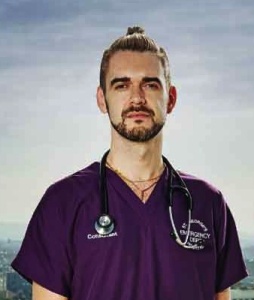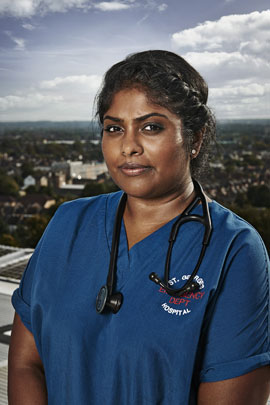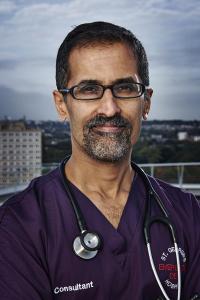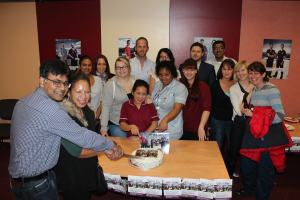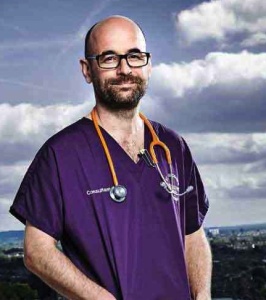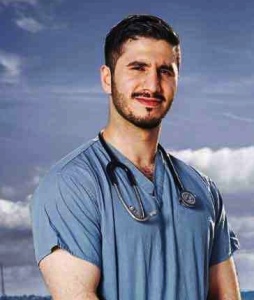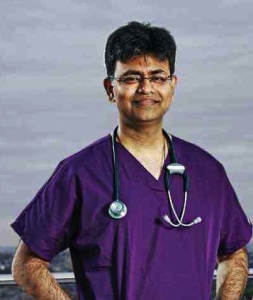Getting to know
Here you can get to know some of the familiar faces you’ll have seen on 24 Hours in A&E over the years…
Getting to know Rhys…
I’m one of the Emergency Department (ED) consultants. I have a special interest in children’s emergency medicine, so spend most of my time working in the Children’s ED.
How long have you worked at St George’s? Why did you want to join the team?
I’ve been a consultant at St George’s since February 2015. St George’s offered a young, enthusiastic and vibrant team that I wanted to be a part of.
How many patients do you treat in an average day? What conditions / illnesses do they have?
We see between 350-450 patients in a 24 hour period. One of the things that I like best about working as a consultant in an Emergency Department is that I can be treating a new born baby one minute and then a 100 year old patient the next.
What did you think when they announced ’24hrs in A&E’ was going to be filmed at St George’s?
I was excited to hear that 24 Hours in A&E would be coming to film at St George’s. Kings hospital did such a great job, and the staff and department were depicted so well. I was pleased to think that the St George’s would have its own moment to shine.
Did you find it had any impact on your day?
I was surprised how little impact the filming had on my day. I got so used to turning up to work and putting on a microphone, and checking in with the “shop floor” producers. The TV company did a great job at making it really easy for me. My priority was always looking after the patients – that never changed.
What have you enjoyed the most from your experience of ’24hrs in A&E’?
It’s been great watching the department’s reaction to the programme. It’s definitely boosted team moral!
What has been your highlight moment of St George’s episodes so far?
It has to be the gentleman who had ketamine for his dislocated shoulder (series 7) and said ‘Everything’s gone wobbley bobbley’.
What was the biggest challenge you experienced during the filming?
As consultants, we were involved with consenting patients to be filmed. Sometimes this was difficult, but the production team were always there to help and support us.
What is the benefit of St George’s participating in a show like ’24hrs in A&E’?
It has been really important to show what a great service the NHS provides.
Is there anything that was or wasn’t caught on camera which you wish wasn’t or was?
I don’t think so – they capture everything in such a great way!
Getting to know Sobi…
I am one of the ED registrars.
How many patients do you treat in an average day? What conditions / illnesses do they have?
I will typically treat between 15-20 patients a day. This will involve people complaining of chest pains, septic patients, traumas and children coming with everyday accidents – so it’s vast and varied.
What did you think when they announced ‘24hrs in A&E’ was going to be filmed at St George’s?
I thought it was a great idea. It gives the public the chance to see the inside workings of the hospital and how closely we work together. It also lets everyone understand the special relationship staff form between each other when working in this kind of environment.
Did you find it had any impact on your day?
To be honest, we are so busy you forget at times the cameras are even there and you just get on with your job.
What have you enjoyed the most from your experience of ‘24hrs in A&E’?
It was wonderful to get an intimate insight into my colleagues’ lives and see what they are like outside of work. This gave me a real good insight into what challenges and problems my co-workers deal with.
What is your highlight moment of the series?
It has to be watching and listening to the children’s feedback. This always brings a smile to my face and gives you a totally different insight into what we do here. Family members equally provide some interesting thoughts as well which always helps you appreciate how valued the public make us feel.
What was the biggest challenge you experienced during the filming?
We deal with high pressure situations all the time, which sometimes involves sad endings. Having a patient’s family and the cameras around during difficult times did make certain situations more difficult. But we have to remember the work we do does not change with or without the cameras.
What is the benefit of St George’s participating in a show like ‘24hrs in A&E’?
It lets the public gain a great fly-on-the-wall perspective of all the important work we do here every day. In addition, it helps the public understand how vital and key our working relationship is – and how this helps us assist all our patients.
What do you think about the reaction to the new series so far?
My friends and family are amazed by the show. They can’t believe how hard we work and the countless cases we deal with. All the feedback I have been given has been very positive and supportive which really puts a big smile on my face.
Is there anything that was or wasn’t caught on camera which you wish wasn’t or was?
Thankfully, none of my cheesy jokes or one-liners were caught on camera or I would have had to hide in shame
Getting to know Sunil…
I am one of the Emergency Medicine Consultants at St George’s. As a group our role is to guide and oversee the medical care provided in the Emergency Department at St George’s.
How many patients do you treat in an average day? What conditions / illnesses do they have?
We treat up to 450 patients a day. We treat the whole range of emergency conditions ranging from the serious and life threatening to those which are less serious. Our expertise is in treating those conditions or illnesses which have developed rapidly and which require emergency treatment.
What did you think when they announced ‘24hrs in A&E’ was going to be filmed at St George’s?
If I’m honest, I was a bit apprehensive but I think that was more because I didn’t know what it involved. I had seen the series at King’s and had been impressed but wondered how the staff had felt about being filmed. As I am not particularly media savvy, I think this added to my nervousness.
Did you find it had any impact on your day?
Having to put a microphone on at the beginning of each shift was a bit odd and this initially made me very conscious of what I said but these feelings soon wore off. Also, I was intermittently conscious of the cameras particularly if I saw them moving to point at me!
What have you enjoyed the most from your experience of ‘24hrs in A&E’?
I have really enjoyed seeing my colleagues and the great work they do and also hearing the incredible stories of the patients that we see. Because of the fast and fleeting nature of our work, we often don’t get to fully appreciate our patients’ backgrounds and everything that has brought them to this point. So it’s nice to hear them talk about themselves and their experiences prior to their attendance in the ED.
What is your highlight moment of the series?
I know this sounds a bit self-centred but my highlight has been seeing how the 24 hours in A&E team constructed the episode I was in within series seven. They have been able to take elements of what I said and have wrapped this around patient stories so the over-riding impression reflects the opening title. I think the 24 hours in A&E team are geniuses and are hugely talented in being able to craft episodes like these.
What was the biggest challenge you experienced during the filming?
I initially found it difficult having to explain to patients that we were being filmed and asking whether they minded. This improved over time though, as patients and their relatives said no when they weren’t happy and agreed to the filming when they were so I was satisfied that they had been able to decide freely with the option to say ‘no’ at any point.
What is the benefit of St George’s participating in a show like ‘24hrs in A&E’?
A series like this gives people a more rounded and complete picture of the complexity of clinical work and helps people understand the jobs we do. There are some incredible, highly-skilled and immensely caring individuals who work at St George’s both inside and outside the ED. A series like this acknowledges staff for the clinical care they provide to their patients. The positive effects on staff of this acknowledgement are immeasurable.
What do you think about the reaction to the new series so far?
I think the reaction has been amazing. I am amazed by the response on social media and impressed how staff have handled the attention they have received.
Getting to know Daryl…
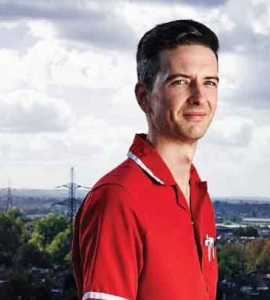 What is your role withing A&E?
What is your role withing A&E?
I am one of the Senior Charge Nurses in the department, I manage a team of nurses in their development as well as the day to day running of shifts when I am in charge.
How many patients do you treat in an average day? What conditions / illnesses do they have?
We see around 350-400 patients everyday with a massive range of injuries and illnesses, it’s very unpredictable.
What did you think when they announced ‘24hrs in A&E’ was going to be filmed at St George’s?
When I first heard that ’24 hours’ would be filming in the department I was slightly apprehensive.
Did you find it had any impact on your day?
The filming didn’t really have an impact on my day, it’s always busy and there’s always something going on so we all just got on with our jobs, wearing a microphone and seeing the cameras just became part of the routine.
What have you enjoyed the most from your experience of ‘24hrs in A&E’?
Going up to the helipad to have the publicity shots done was probably the highlight since staff aren’t allowed to go up there in normal circumstances. It was a really sunny day and you could see the whole of London.
What was the biggest challenge you experienced during the filming?
I found it all quite easy going.
What is the benefit of St George’s participating in a show like ‘24hrs in A&E’?
It will showcase the variety in our day to day shifts and show what an amazing team we have in the department.
What do you think about the reaction to the new series so far?
As far as I can tell its all been positive so far, hopefully that will continue, my wife and daughter are certainly enjoying it.
Is there anything that was or wasn’t caught on camera which you wish wasn’t or was?
I think there will always be cases that were really interesting but consent was an issue or the patient was in an area where there wasn’t a camerabut I think the ’24 hours’ team did a great job at capturing us all at work.
Getting to know Sandra…
I’m a staff nurse.
Why did you decide to become a nurse?
I became a nurse after I lost my eldest son in a car accident.
How many patients do you treat in an average day? What conditions / illnesses do they have?
We see hundreds of patients on a daily basis.
What did you think when they announced ‘24hrs in A&E’ was going to be filmed at St George’s?
I was very wary when I knew 24 hours cameras were coming in, my biggest fear was professionalism, confidentiality and dignity, from a patient perspective.
Did you find it had any impact on your day?
At first I was very unsure of cameras, but soon forgot they were here and carried on as normal. In fact sometimes I forgot the microphone was on and went to the loo to spend a penny. I cringe at them listening to me tiddle in the gallery!
What have you enjoyed the most from your experience of ‘24hrs in A&E’?
The 24 hours team seemed to blend into the background and was part of the team too. They were very polite and not at all intruding.
What is your highlight moment of the series?
I think seeing our department in the first episode on TV was great! It portrayed just how strong and professional our team is.
What was the biggest challenge you experienced during the filming?
The biggest challenge was doing the interview on camera. It was a weird experience! I nearly didn’t do it, I usually don’t like even like having a photograph being taken as I am very camera shy.
What is the benefit of St George’s participating in a show like ‘24hrs in A&E’?
St George’s will benefit from the series as it will show that we are a great team, and how hard it is working within the NHS, but also it can be so very rewarding.
Is there anything that was or wasn’t caught on camera which you wish wasn’t or was?
I looked after a young man who fell off a zip wire, he totally lost his memory and was chatting about seeing his grandfather in the ambulance. Suddenly he burst into tears as he said he had just remembered his granddad had died a few years ago.
We were looking after him and his sister started to get tearful when she saw me, and said I looked like their mum who died. She had brought her brother up and looked after him as a child.
I had to hide in another cubicle because they moved me to tears. I wondered whether he really did see his granddad, was he looking after him in the ambulance? Sadly this was not caught on camera, but I will never forget this young man.
Weeks later I received a card saying he still does not remember what happened that night in A&E but he remembered me so well, and how grateful he was for my care, I cried again!
Getting to know Will…
I am a Consultant of Emergency Medicine and Pre-Hospital care with a both a clinical and teaching role.
How long have you worked at St George’s?
I have worked at St George’s since April 2012.
How many patients do you treat in an average day? What conditions / illnesses do they have?
We treat roughly 400 patients – both adult and paediatric – per day, ranging from minor illness and injuries to major trauma and cardiac arrests.
What did you think when they announced ‘24hrs in A&E’ was going to be filmed at St George’s?
I was very excited about the project and would be a great opportunity for the Trust to show what amazing work the team performs on a daily basis 24 hours a day, 365 days of the year.
Did you find it had any impact on your day?
The filming process had very little impact on our day to day work – the cameras were very soon forgotten and genuine natural work was captured.
What have you enjoyed the most from your experience of ‘24hrs in A&E’?
I have enjoyed the positive feedback about our department from the first episode – a real boost to the team.
What is your highlight moment of the series?
The high quality care in an empathic manner we deliver to our patients.
What was the biggest challenge you experienced during the filming?
The greatest challenge was consenting and informing patients to the series. The delicate balance of ensuring no pressure is put on them to be involved and that it is their care is the most important thing.
What is the benefit of St George’s participating in a show like ‘24hrs in A&E’?
We, as a whole Trust, should be very proud of the healthcare we deliver – all day, every day.
What do you think about the reaction to the new series so far?
Only positive.
Getting to know Mo…
As a trauma registrar you must be present at all major trauma calls and lead the assessment and management of the unwell patient in conjunction with the emergency department consultant.
How many patients do you treat in an average day? What conditions / illnesses do they have?
Obviously this ranges, but on average we can deal with up to five or six major trauma calls in any 12 hour shift. These patients will have suffered “polytrauma” (meaning multiple injuries) and therefore may have head, chest, abdominal, pelvic and limb injuries. We lead patient care and coordinate with other specialities when their input is also required.
We may also admit another similar number with relatively less severe injuries, such as hip, spine or limb fractures, and we may review many more and discharge them from A&E. We also support the entire hospital’s inpatients, and its partner hospitals for tertiary centre advice, as well as local GPs.
What did you think when they announced ’24 Hours in A&E’ was going to be filmed at St George’s?
I was anxiously excited but what a great opportunity for the hospital to showcase the fantastic job it does treating its patients.
Did you find it had any impact on your day?
No. Well, at first I felt the cameras presence, but that soon disappeared.
What have you enjoyed the most from your experience of ’24 Hours in A&E’?
The love and support that has been shown!
What was the biggest challenge you experienced during the filming?
Everyone warned me off not being involved… Apparently at best you could come off looking normal. I’m glad I had the courage to engage with the fantastic production team.
What do you think about the reaction to the new series and your part in it?
I’ve been massively overwhelmed.
What is the benefit of St George’s participating in a show like ’24 Hours in A&E’?
It’s a first class hospital and people should see that. I hope it does the hospital a great deal of positive publicity.
Is there anything that was or wasn’t caught on camera which you wish wasn’t or was?
There was a young polytrauma patient involved in a high speed head on collision that had numerous severe injuries including an open chest wound, intrabdominal injuries and a fracture dislocation of his hip. I washed out his thoracic wall/cavity, put a chest tube in and reduced his hip dislocation. This would have made great TV, but more importantly I would have loved to see his progress as we had to transfer him elsewhere.
Getting to know Louise…
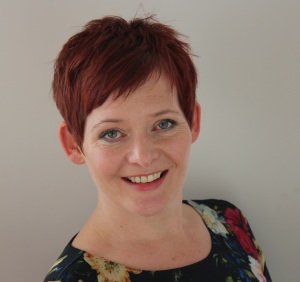 Louise Halfpenny was the Head of Communications at St George’s. She was instrumental in securing St George’s as the new home for ’24 Hours in A&E’.
Louise Halfpenny was the Head of Communications at St George’s. She was instrumental in securing St George’s as the new home for ’24 Hours in A&E’.
Why did the Trust agree to be filmed for the series?
We thought it would be a great way to show the public what really goes on behind the scenes of a busy emergency department. We’re proud of our staff and what they achieve. You’d have to be – there’s no hiding place with more than 100 cameras in place!
How much was the Trust paid for being part of the series?
We were given a facility fee for taking part.
Where will the revenue go?
Some of it was used for additional staff time needed to make the show happen and some will be used to begin much-needed improvements to our intranet.
Were staff paid for participating in the series?
No, not directly. When we needed staff to spend time to help with the programme then money was used to backfill them so that patient care was not affected.
Did all patients give their consent to be filmed for the series?
Yes. Absolutely!
How did you know that patients were able to give consent?
Before filming started the Trust carefully considered the consent process. Our medical director, information governance leads and our legal team looked through the production team’s processes very carefully and were happy with their approach. A contract was then signed. In addition, we spoke to colleagues at King’s where the series had been filmed previously. Their experience gave us even greater assurance about consent.
How much disruption did the filming cause for patients?
Hardly any. There were only a couple of members of the production team in the department at any one time. The cameras are installed so there weren’t lots of people filming patients. The cameras were operated remotely.
How did you make sure patients, visitor and staff were kept safe during filming?
The cameras and cabling were installed when the emergency department was at its quietest. Our own estates team played an important role in overseeing this – often at very unsociable hours. We also organised a briefing for more than 100 staff from The Garden Productions to tell them about safety, conduct and infection control measures before filming started. We’re grateful to The Garden Productions and our estates staff for doing all they could to minimise disruption and put safety first.
Wasn’t it distracting for doctors/nurses to be filmed while treating patients?
Staff are focused on treating patients first and foremost. Everyone soon got used to them. Some staff, patients and their visitors also wore mics but only if they were completely happy to do so.
Was it really necessary to show such graphic scenes of injuries?
The programme is broadcast after 9pm and its title suggests what might be included. Serious injuries are part of everyday life in a major trauma centre like the one at St George’s. Many of the more gruesome shots have been edited out but it was important to leave in footage that formed an important part of the patient’s story.
Getting to know Jai…
Care Group Lead & Consultant Adult and Paediatric Emergency Physician
How many patients do you treat in an average day? What conditions / illnesses do they have?
The department receives approximately 350 new patients a day. When I am on a clinical shift, I normally work a 9.5 hour shift. The number of patients I see depends on the area I work. For example, resus work would involve seeing less number of patients compared to majors or in urgent care as resus patients are more sick. However, on an average I would see approximately 20 patients per shift. I encounter different patients depending on the location I work. For example in resus patients present with major trauma, cardiac arrest, sepsis, chest pain, difficulty in breathing, dislocation of joints / fractures, whereas in urgent care patients present with minor injuries and minor illnesses. I also receive and treat children presenting with various illnesses and injuries.
What did you think when they announced ‘24hrs in A&E’ was going to be filmed at St George’s?
I was involved with the ‘24hrs A&E’ project at the very beginning and showed eagerness and enthusiasm which enabled St George’s to reach the final shortlist. The Clinical Director Dr Phil Moss and Clinical Director for Major Trauma Dr Heather Jarman helped the ED secure the project.
Did you find it had any impact on your day?
At the outset, the filming I felt did have a slight impact on most of the staff including myself. We were a bit anxious as we felt the presence of cameras a bit voyeuristic and wanted to ensure that we came across well and represented the department and the trust in good light. However, after a couple of weeks we naturally slid into our normal working style as our work normally encapsulates and reflects our trust values of being Kind, Excellent, Responsible and Respectful.
What have you enjoyed the most from your experience of ‘24hrs in A&E’?
I have enjoyed and learnt from watching “ER” series when I was growing up and the ER music still echoes in my head whenever I walk into the resus room. I had a secret desire to appear on a TV show. 24 Hours in A&E made it possible on two counts; I appeared in their initial episodes as well in their pre-title sequence. There are a lot of good learning points in the programme both for the public and doctors alike. I hope this series will prove to be as informative and appealing as ER was to me!
What is your highlight moment of the series?
Series 7 kicked off with a young female who was involved in a major trauma (amputated her leg and fractured her thigh). Receiving and treating her from an out of area helicopter emergency crew would be my highlight as I was involved and wanted to do the best for her as she reminded me of my elder daughter who was only a few years younger to her.
What was the biggest challenge you experienced during the filming?
The biggest challenge I faced during filming was to keep my banter with my ED staff under check. I am known to be cheeky!
What is the benefit of St George’s participating in a show like ‘24hrs in A&E’?
The benefit of St George’s participating in a show like 24hrs in A&E is to show to the world what an Awesome and Audacious A&E team, St George’s possesses. We are seen to be Effective, Efficient and most of all Caring!!
Is there anything that was or wasn’t caught on camera which you wish wasn’t or was?
There are number excellent colleagues from various sections of the department and from the rest of the hospital who were caught on camera during the filming, some of us more so than others. However, what I want to emphasise is the greatness of the ED team does not only belong to those who appear on the TV screen but to every member of the department and hospital team who work tirelessly every day to deliver the best possible care for the patients coming into St George’s ED. Every member of such a large team could not be adequately captured on camera. However, I am ever so grateful to be part of such an awesome team!


